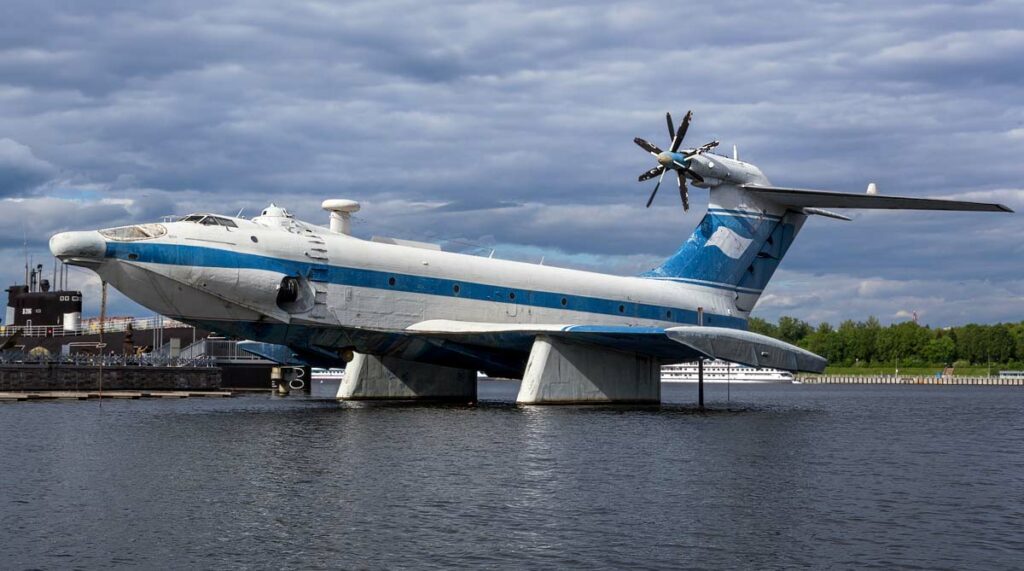Soviet-era ekranoplan, combining features of both aircraft and ship for ground effect flight.
In brief
The CHDB A-90 Orlyonok is a Soviet ground effect vehicle, designed to glide close to the surface of the water, using lift generated by the ground effect of its large wings. It’s powered by one Kuznetsov NK-12MV turboprop engine for lift and three Kuznetsov NK-8-4K jet engines for cruise, achieving a speed of up to 250 knots (463 km/h). With a range of approximately 800 nautical miles (1,482 km) and a maximum takeoff weight of 140 tons, the Orlyonok was primarily used for fast military transport over water, capable of carrying troops, equipment, and vehicles.
History of the Development of the CHDB A-90 Orlyonok (Eaglet)
During the height of the Cold War in the 1960s, the Soviet Union sought innovative military transport solutions that could exploit the vast expanse of its territories and shorelines. The CHDB A-90 Orlyonok, conceptualized by designer Rostislav Alexeyev, emerged from this strategic necessity. The project was aimed at creating a versatile craft that could rapidly deploy forces and hardware by skimming over water surfaces, bypassing traditional maritime routes and avoiding terrestrial obstacles like rough terrain or enemy fortifications.
The program commenced in the early 1970s under the supervision of the Central Hydrofoil Design Bureau (CHDB). The first prototype of the Orlyonok flew in 1972, and after extensive testing and modifications, it was introduced into service in 1979. The Orlyonok, designated by NATO as the “Eaglet,” reflected a unique blend of aerodynamics and naval architecture, embodying the Soviet penchant for massive, unconventional military engineering projects.
The development of the Orlyonok was not just a technological endeavor but also a strategic response to the perceived needs for mobility and quick deployment capabilities in potential conflict scenarios involving NATO forces. The vehicle was envisioned to transport troops and equipment swiftly across the Black and Caspian Seas, providing the Soviet military with a significant tactical advantage.
Design of the CHDB A-90 Orlyonok (Eaglet)
The A-90 Orlyonok’s design stands out for its aerodynamic and maritime engineering integration. It features a 190-foot (58-meter) length and a wingspan of 103 feet (31.5 meters). The hull is made from aluminum and designed for minimal water resistance. The ekranoplan operates using a ground effect, which occurs between the craft and the water’s surface, enhancing lift and reducing drag at low altitudes.
The vehicle is equipped with one Kuznetsov NK-12MV turboprop engine mounted on the tail for creating lift during takeoff and three Kuznetsov NK-8-4K turbojets placed on the front for cruising. This combination allows the Orlyonok to reach speeds of up to 250 knots (463 km/h) while flying just meters above the sea surface.
However, the design also presents certain limitations. The reliance on ground effect confines operations largely to calm weather and smooth seas, as rough conditions can disrupt the air cushion vital for its efficient operation. Additionally, the complexity and cost of maintenance of its unique propulsion systems and the structural stress of operating in such an environment pose significant operational challenges.

Performance of the CHDB A-90 Orlyonok (Eaglet)
The Orlyonok’s performance metrics are impressive for its class. It achieves a maximum speed of 250 knots (463 km/h) and has a range of about 800 nautical miles (1,482 km). The vehicle can carry up to 200 troops or 80 tons of cargo, making it an effective tool for rapid deployments. The operational ceiling, while typically not exceeding 10 feet (3 meters) above the surface due to the ground effect, underscores its unique niche within military transport.
When compared to other military transport methods like large military cargo aircraft or traditional naval ships, the Orlyonok offers distinct advantages in speed and deployment capabilities close to shorelines, though it lacks the global reach and all-weather operational flexibility of more conventional aircraft.
Variants of the CHDB A-90 Orlyonok (Eaglet)
The primary production model of the Orlyonok was the A-90. However, several variants were conceptualized and tested, including upgraded versions with enhanced avionics and increased cargo capacity. Some proposed modifications aimed to extend its operational range and improve reliability in adverse weather conditions, though few of these variants reached full-scale production due to the dissolution of the Soviet Union and subsequent funding constraints.
Military Use and Combat of the CHDB A-90 Orlyonok (Eaglet)
The Orlyonok was primarily used by the Soviet Navy for rapid troop and equipment transport across bodies of water, leveraging its speed and near-shore operation capabilities. It was never actively engaged in combat, serving instead as a high-speed transport link between various naval bases and deployment zones along the Soviet coastlines.
Despite its potential, the Orlyonok did not see export to other countries, and with the end of the Cold War and the breakup of the Soviet Union, operational interest and financial support waned. The remaining vehicles were retired from active service in the late 1990s, replaced eventually by more conventional air and sea transport methods which, while slower, offered greater versatility and operational range.
The CHDB A-90 Orlyonok represents a remarkable period in military engineering where the boundaries of aviation and maritime technology were tested. While ultimately limited in application, its development and service life underscore the innovative approaches to strategic military mobility during the Cold War.
Back to the Seaplanes section.